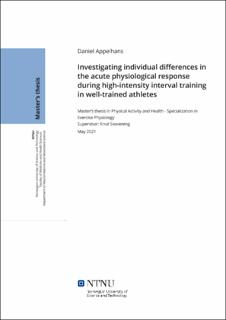| dc.description.abstract | In previous studies comparing different interval protocols, large individual differences in time above 90% of maximal oxygen consumption (t > 90%V̇O2max) have been observed. Even though t > 90%V̇O2max is regarded as an important parameter in quantifying the effectiveness of high-intensity interval training (HIIT), the reason for this variation has not been investigated. Therefore, this master thesis aims at investigating the individual differences in. t > 90%V̇O2max in well-trained athletes between different interval protocols and modes of intensity prescription
Twelve well-trained cyclists and triathletes (V̇O2max: 68 +- 6.3 L·min-1·kg-1) performed two different interval protocols of 3x13x30/15-seconds (IM) and 6x5-minutes (TRAD) twice in a randomized order. Each protocol was first performed with a fixed intensity (Fixed) based on percentages of maximal aerobic power (MAP) and the next time self-paced with a maximal session effort (Free).
Neither fractional utilization of V̇O2max (%V̇O2max@AT) nor time-to-exhaustion at MAP (Tlim) was correlated with the t > 90%V̇O2max in any of the sessions. Additionally, no other physiological parameter assessed in this study could predict t > 90%V̇O2max. The coefficient of variation (CV) for t > 90%V̇O2max was lower for IM (18%) and TRAD (31%) in Free compared to Fixed (IM: 62% and TRAD: 90%), and all physiological parameters assessed were higher in Free than Fixed (all p < 0.001; all ηp2 > 0.795). Every participant could work at a higher intensity in Free, but the degree of work intensity was individual. In IM, this degree of a greater work rate was positively correlated to the change in t > 90%V̇O2max between the two exercise modes (p < 0.05; r = 0.669). The t > 90%V̇O2max was significantly higher for IM than TRAD in Fixed (p < 0.01) but not in Free (p = 0.321).
The large individual differences in t > 90%V̇O2max following a HIIT session seem rather influenced by the methodology of prescribing a fixed intensity instead of differences in physiological parameters. Using the self-paced maximal session effort and a time-matching which includes the 15-seconds rest of IM as interval time, reduces the physiological differences between IM and TRAD, indicating a more uniform cardiovascular stimulus than previously reported. | |
